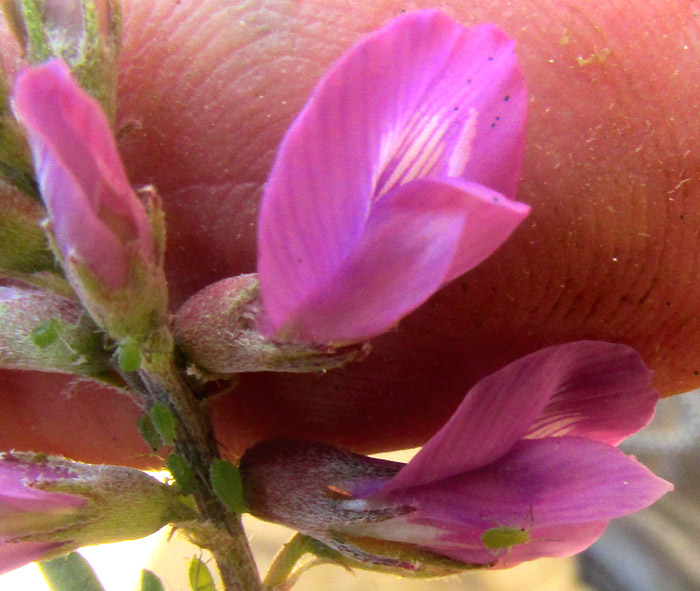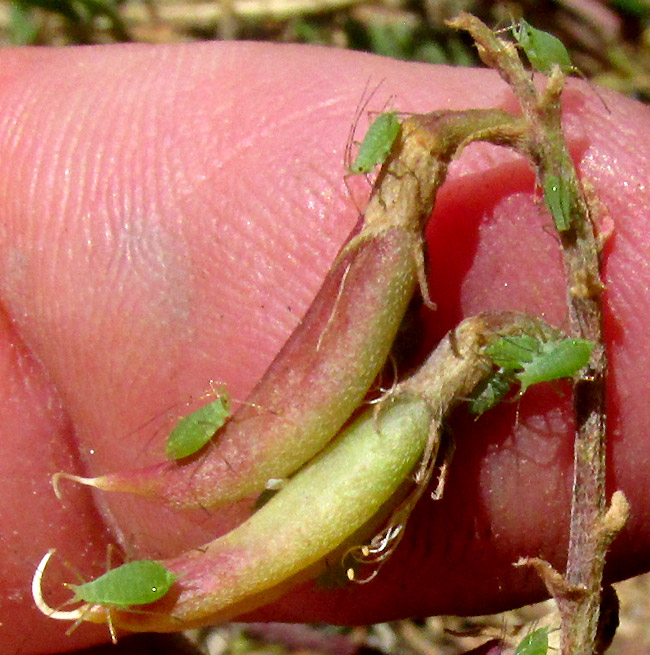Excerpts from Jim Conrad's
Naturalist Newsletter
Entry from field notes dated June 30, 2023, from along narrow, very steep, cobblestone road descending on the south side of El Doctor, passing among cultivated fields and pastures; in the mountains of east-central Querétaro state, municipality of Cadereyta de Montes, 12 straight-line kms due east of Vizarrón de Montes but much farther by twisting roads; elevation ~2740m (~8900 ft), Querétaro, MÉXICO, (N20.84704°, W99.58573°)
HALFMOON MILKVETCH

On rocky debris below an old roadcut in limestone, a much branched, sprawling, bushy herb with tough but not woody stems produced the above raceme of bean-type flowers. Note its feathery, pinnately compound leaves.

With five petals forming a bilaterally symmetrical corolla consisting of five petals, of which a large standard or banner arose at the top, with two side petals as wings, and the two lower petals below fused along their common borders to form a keel, our plant was a classic Bean Family member, of the subfamily Faboideae. Note the short, white hairs lying close to the calyx's surface. The blossoms' small size can be judged by the green aphids, of which the plant hosted many.

Immature, legume-type fruits were forming on some branches. Unlike many legumes in this family, these were were round in cross-section and somewhat succulent looking. Aphids seemed to like them.

On pale pinkish stems, the leaves consisted mostly of about 10-15 pairs of narrowly egg-shaped, or oval, leaflets. When identifying bean family members with such leaves, usually it's important to note whether at the tip of the stem the leaflets grow from, the rachis, there's a leaflet, bristle, tendril or nothing. On these leaves a small leaflet was present. Here's what the whole plant looked like along the somewhat trashy road, its flowers hardly visible at a distance:

In our part of upland central Mexico in and nearby the region known as the Bajío, if your Bean Family member of the subfamily Faboideae is a non-woody bush about knee high with its leaves bearing leaflets in about 10-15 pairs, with a leaflet at the tip of the rachis, the leaflet margins aren't finely toothed and leaflets aren't covered with tiny glands, the fruits aren't segmented, the flowers arise along the rachis atop a short stalk, or pedicel, the corollas are pinkish-purple, and the blossoms' styles are not "bearded" with a tuft of hairs at their tips, you have the most species-diverse genus in the Bean Family (over 3000 species, though most people haven't heard of it), the genus Astragalus. Species of Astragalus often are known as the milkvetches, though probably in the US the best-known ones are called locoweeds.

On your Astragalus, if the stipules -- in the picture at the right, the brownish, papery, triangular items at the base of each petiole -- don't unite with the stipule opposite them on the stem, the corolla's standard is taller than 9mm (3/8inch), the fruit is almost circular in cross-section and, at least when mature, conspicuously "inflated" or bladder-like -- beans inside surrounded by open space -- you have ASTRAGALUS WOOTONII, in English often called Halfmoon Milkvetch, probably because the mature fruits are a little curved like a half moon. Also it's often named Wooton's Locoweed.
Astragalus wootonii has an English name because it occurs in drier parts of the southwestern US, then south in the uplands to central Mexico. Some authors regard the species as a mere variety known as Astragalus allochrous var. playanus. However, Kew's Plants of the World database maintains our plant as a distinct species.
In a USDA research paper entitled "Astragalus and Oxytropis Poisoning in Livestock," reporting on a project ended in 2008, it's said that locoweed is especially poisonous to horses. Wild animals are relatively resistant, and cattle and sheep display intermediate susceptibilities. Our Astragalus wootonii was found to be the most toxic of the species tested.
The cause of the toxicity of Astragalus is an alkaloid known as swainsonine. The report says that horses are especially sensitive to it, becoming hyper-excitable, frightened, or violent when stimulated. Further, "The locoweed toxin swainsonine adversely affects fetal health, resulting in death and abortions, and disrupts the estrus cycle in females and causes male infertility." Astragalus has thus not only found a way to cause animals who might eat it to keep away from them, but to reduce their numbers in the first place.
Interestingly, it appears that the alkaloid swainsonine isn't produced by Astragalus plants themselves, but rather by a fungal "endophyte." Endophytes are organisms, typically fungi or bacteria, living between a plant's cells. In Astragalus, the swainsonine-producing endophyte known as Undifilum oxytropis has been detected in certain species.
Even more interesting is that in New Mexico State University's Guide B-713 entitled "Locoweed Poisoning of Horses" it's reported that once horses begin feeding on locoweed, their consumption over time increases. It's theorized that "This is most likely due to the fact that animals that continue to graze on locoweed develop habituation, or a psychological 'need' for swainsonine, that causes them to more readily seek out and consume locoweed."
Not only does our plant make horses act crazy, or loco in Spanish -- the authors say the horses become "locoed" -- but it's addictive to them.